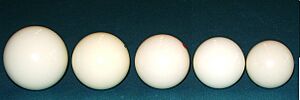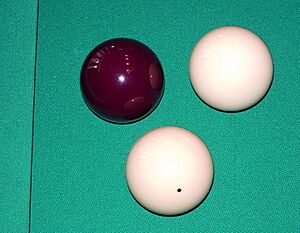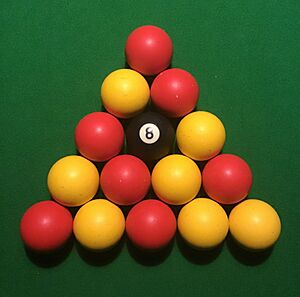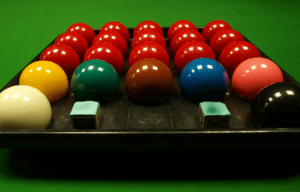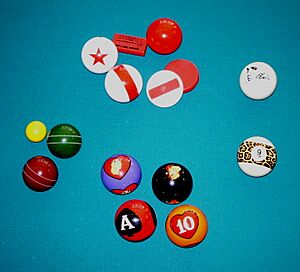Billiard ball facts for kids
A billiard ball is a small, hard ball used in cue sports. These games include carom billiards, pool, and snooker. The balls come in different numbers, types, sizes, colors, and patterns. This depends on the specific game being played. Important features like how hard they are, how they roll, and how bouncy they are help players aim accurately.
Contents
Different Types of Billiard Balls
Carom Billiards Balls
In carom billiards games, players usually use three balls. These games are played on tables that do not have pockets. Carom balls do not have numbers on them. They are about 61 to 61.5 millimeters (about 2.4 inches) wide.
Here are the usual colors for carom balls:
- A white cue ball for player 1.
- A white ball with a spot, or a yellow ball, for player 2.
- A red (or sometimes blue) object ball. The game four-ball uses an extra object ball.
Pool Balls
Pool balls are used for many pool games. Some popular games are eight-ball, nine-ball, and straight pool. These balls are smaller than carom billiards balls but larger than snooker balls.
According to the World Pool-Billiard Association, pool balls should weigh between 5.5 and 6 ounces (156 to 170 grams). They should be about 2.25 inches (57.15 millimeters) wide.
| 1 | solid yellow | |||
| 2 | solid blue | |||
| 3 | solid red | |||
| 4 | solid violet | |||
| 5 | solid orange | |||
| 6 | solid green | |||
| 7 | solid maroon | |||
| 8 | solid black | |||
| 9 | yellow stripe | |||
| 10 | blue stripe | |||
| 11 | red stripe | |||
| 12 | violet stripe | |||
| 13 | orange stripe | |||
| 14 | green stripe | |||
| 15 | maroon stripe | |||
| • | cue ball, white or off-white (sometimes with one or more spots) | |||
The balls are numbered and colored as shown in the table. Balls 1 through 7 are called "solids." Balls 9 through 15 are called "stripes." Striped balls first appeared around 1889. The 8 ball is black and is not considered a solid, even though it looks like one.
In some games, like nine-ball, the numbers on the balls are important. In other games, like eight-ball, all sixteen balls are used. But in games like seven-ball, nine-ball, and ten-ball, only certain numbered object balls are used, along with the cue ball.
Some pool balls used on TV have different colors. This helps viewers tell them apart. For example, the dark purple (4 and 12 balls) might be pink. This makes it easier to see the 4 ball next to the black 8 ball. Also, the 7 and 15 balls might be light tan instead of dark red. These special sets often have a cue ball with spots. This helps viewers see the spin a player puts on the ball.
Pool tables that take coins, like those in arcades or bars, sometimes use a slightly different-sized cue ball. This allows the table to separate the cue ball from the other balls. It sends the cue ball back to the player. Some tables use a magnet to pull a cue ball with metal inside it. This lets the cue ball be closer in size and weight to the other balls. Newer tables use optical systems that "see" the cue ball and separate it.
Blackball Pool Balls
In blackball pool, there are fifteen object balls. They are divided into two groups: reds (or sometimes blues) and yellows. These balls do not have numbers. There is also a white cue ball and a black 8 ball.
Because the balls are not numbered, players do not "call" their shots. This means they don't have to say which ball they will pocket. These balls are not good for games like nine-ball, where the order of balls is important. Blackball balls are usually smaller than American-style pool balls. The most common sizes are 2 inches (50.8 mm) and 2.06 inches (52.3 mm) wide.
Sometimes, the yellow and red sets are called "casino sets." This is because they were used for televised championships, often held in casinos. Special sets for TV games also exist for blackball. These sets have an 8 ball with a black stripe and a spotted cue ball.
Snooker Balls
| Colour | Value |
|---|---|
| 1 point | |
| 2 points | |
| 3 points | |
| 4 points | |
| 5 points | |
| 6 points | |
| 7 points |
A set of balls for snooker has twenty-two balls in total. There are fifteen unmarked red balls. There are also six color balls placed in specific spots on the table. Finally, there is a white cue ball. For home use, the color balls sometimes have their point values printed on them, like pool balls.
Snooker balls are usually 52.5 millimeters (about 2.06 inches) wide. All balls in a set must weigh almost the same. Many sets are actually 2.06 inches (52.3 mm) wide. Smaller snooker sets are also available for smaller tables. These are allowed in some amateur leagues.
The eight colors used for snooker balls (including white) might come from the game of croquet. Croquet uses the same colors. Snooker was invented in 1884 by British Army officers in India. Croquet was very popular at that time, especially among people in similar social groups. There are many similarities between croquet and snooker, suggesting that snooker was inspired by croquet.
Balls for Other Games
Many other cue sports games have their own special billiard balls. English billiards uses the same number of balls as carom billiards. However, the balls are the same size as snooker balls. This is because the game is played on the same size table as snooker.
Russian pyramid uses fifteen numbered balls that are all white. It also has a red or yellow cue ball. These balls are even larger than carom billiards balls, at 68 millimeters (about 2.68 inches) wide. Kaisa uses the same table and ball sizes. But it only uses five balls: one yellow, two red, and two cue balls (one for each player).
Bumper pool needs four white and four red object balls. It also uses two special balls: one red with a white spot, and one white with a red spot. All these balls are usually 2.125 inches (54 mm) wide. Bar billiards uses six or seven white balls and one red ball, all about 1.875 inches (47.6 mm) wide.
Fun and Unique Billiard Balls
You can find special cue balls and even full sets of balls with fun designs. These might have sports team logos, cartoon characters, animal patterns, or other cool decorations.
Inventors also create new billiard games with unique rules and balls. Some balls look like playing cards, others have stars and stripes. Some sets have more than thirty balls in different "suits." Balls with marbled looks or glitter are also popular for home tables. There are even special sets that glow under blacklight for playing in the dark!
You can also find trick cue balls and 8 balls. These have weights inside that are not centered. This makes them roll in funny curved or wobbly paths. Smaller sets of balls are also common. They are usually two-thirds or half the normal size. These are mostly for toy tables. There's even an egg-shaped ball that has been patented and sold!
Images for kids
-
Hyatt's patent for a celluloid billiard ball from 1871.
See also
 In Spanish: Bola de billar para niños
In Spanish: Bola de billar para niños


